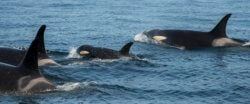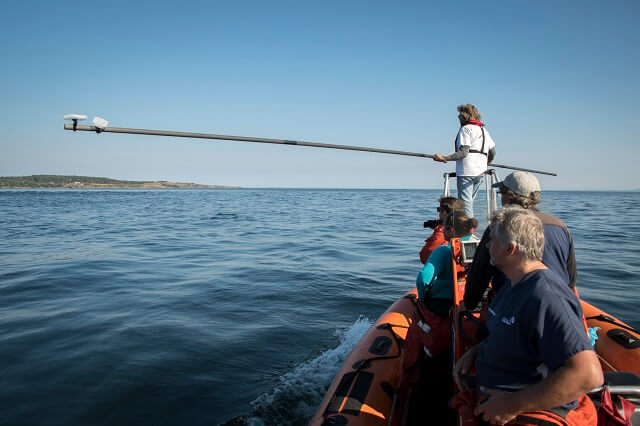Last month, it was the orca Tahlequah. Tahlequah (J-35) had given birth to a daughter, but the baby had survived just half an hour. And all around the world people watched, transfixed as Tahlequah proceeded to carry the body of her infant for more than two weeks and more than a thousand miles in what could only be interpreted as a display of profound grief and loss.
And now here we are again. On Thursday, September 14th, another member of the “J” pod of Southern Resident orcas was declared dead by the Center for Whale Research. Four-year-old Scarlet (J-50), sick, starving and emaciated, had not been seen for more than a week.
Scarlet had had a difficult start in life. Rake marks seen along her body soon after she was born suggested that she’d been a breech baby and that family members had midwifed her out of her mother Slick (J-16).
But she was a vibrant and energetic youngster who soon became something of a celebrity – a wildlife photographer’s dream – as she would launch herself out of the water in a perfect arc, nose pointing to tail, over and over again.
It didn’t last. By age three, she was looking thin and clearly weaker. And by the time she approached age four, she was the size of a two-year old.
Joe Gaydos, a wildlife veterinarian with the SeaDoc Society, called her “the thinnest killer whale I have ever seen.” But as sick as she was, Scarlet was determined to keep up with her family in their daily travels through the Salish Sea in search of food.
“She was like this little Energizer bunny that just keeps going and going, and definitely captured our hearts,” Dr. Gaydos said.
* * *

Scarlet with her family in mid-August. Photo by Katy Foster/Whale Sanctuary Project under NOAA permit 18786.
Scarlet’s family was already in trouble. A dwindling supply of their main diet, chinook salmon, along with a growing supply of environmental and noise pollutants, was making life harder for the three pods – J, K, and L – that make up the subspecies known as the Southern Resident Killer Whales. And since they are now designated an officially endangered population, it was up to the National Oceanic & Atmospheric Administration (NOAA) to determine whether action should be taken to save Scarlet’s life, and if so how much. Any decision would have to take into account that orcas have especially strong social and family ties. And human interference with Scarlet could cause added stress to the rest of the pod.
We would not support her transfer to a display park or aquarium.
More than a dozen organizations collaborated under the auspices of NOAA in the effort to save Scarlet’s life. The Whale Sanctuary Project team was led by our site-search and rehab coordinator Jeff Foster. One of the world’s experts in cetacean rescue, Jeff supervised the rehab of the orphan orca Springer in 2002 and the humane capture of sea otters during the Exxon Valdez oil spill. And his dolphin rescue work during Hurricane Katrina won him the honor of being named by NOAA as Environmental Hero of the Year.
Setting aside their work at possible sanctuary locations in British Columbia and Washington, where they were conducting environmental analyses, Jeff and Katy (his wife and rescue partner) worked with NOAA and the other organizations to develop the protocols to help Scarlet, and Katy also documented the rescue effort. (Most of the photos and videos in our updates were taken by her.)
And since NOAA could not fund the costs of the participants, we were grateful to all of you whose donations made it possible for us to be involved.
From the beginning, we made it clear that we would take part in the effort as long as Scarlet continued to swim free with her family group. Only if she were to live-strand or become separated from them would we then support taking her to an ocean-based sea pen for temporary treatment prior to returning her to her pod. And under no circumstances would we support transferring her to an entertainment park or aquarium.

Jeff Foster prepares to take a breath sample from Scarlet. Photo by Katy Foster/Whale Sanctuary Project under NOAA permit 18786.
As the plan took shape, the protocol that Jeff recommended required that the team would first collect breath and fecal samples for analysis. Then Scarlet would receive antibiotics and other medication through injection (via a dart) or by offering her medicated fish. If her condition still deteriorated, there would be an option to pick her up – but only if she were acoustically separated from her family.
Once on board a boat, she would be examined and given medication, and preferably be put straight back in the ocean. But if her condition demanded it, she could be brought to a sea pen for more treatment and to build up her weight to the point where she could be returned to her family.

Springer being treated in her sea pen in 2002. Photo by Dept. of Fisheries and Oceans, Canada.
Something similar had been done 16 years earlier when an ailing orca, known as Springer, began approaching boats. She was taken to a sea pen, where she was fed and medicated for a month and then taken up to British Columbia and reunited with her Northern Resident pod.
The rescue/rehab was a major success, and Springer has since given birth to two calves. And while Scarlet’s situation was different (for starters, Springer was considered an orphan), the same sea pen was still available.
Scarlet did get two antibiotic shots, but she continued to decline, and so plans were made to pick her up if she were to become acoustically separated from her family.
But the rescue team never found her in a situation where they could pick her up. The last time she was seen was on September 7, when she was lagging up to a mile behind the rest of the family but still acoustically in touch with them.
Keeping tabs on the pod was difficult in itself, since orcas can travel up to a hundred miles a day. But when we next saw the family, a couple of days later, Scarlet’s mother Slick was not among them. We guessed that she had gone to be with Scarlet and had stayed with her until the youngster could no longer hold her head above the water.
And when we next saw Slick, she was back with the rest of the family, but with no further sign of Scarlet.
* * *
It has always been part of our plan that at any sanctuary we create for captive whales, rescue and rehab of free-ranging whales will also be part of our work. But Scarlet’s plight propelled us into that side of our mission earlier than expected.
We couldn’t save her, but we believe the effort was worthwhile, both in itself and for the future. That’s because sooner or later – probably sooner – there will be another Southern Resident orca in trouble. And when that happens, and if the team that worked together from the start of this mission can collaborate again, then Scarlet will have left a legacy of hope for the future of her family.
15 Comments
Well, now from what I am hearing there are 3 pregnant females in the SRKWs and now K25 is ailing who is a young male capable of producing more off spring, so he needs to live!
I can’t even say that I am happy for the pregnancies because humans have failed to leave them a world to be born healthy in…NOW WHAT???
She was known as the “happiest whale alive” because of her constant breaching, of which I was lucky to witness last summer! So, I felt that if any baby would make it…she would! She almost did but human greed was too much for her. My heart is broken, she had a bit of a rough start to this world but got some help from family and thrived..the first one of the baby boom class
The tour of grief featured on our main tv network prime time news in New Zealand and I have followed every detail since. I only ever knew a very sick, young, brave little orca for a short time but grieving all the same. I am shocked this is happening on the doorsteps of the world’s wealthiest nation. My thoughts are with all of those who know the srkw personally.
I am following from Germany. Thank you for all your efforts to save little Scarlet. She will never be forgotten, she was a fighter. RIP little Scarlet. I wrote many e mails to Gov./Sen/ and the Task Force Team, please breach the dams NOW!! The beautiful orcas need our help and more protection (expecially of boats/pipelines/noise) NOW! Thank you very much.
I have been following Scarlet’s story from Australia for a good while now and found myself in tears quite regularly. I am so sad to hear that she is no longer with us. She captivated me with her spirit as has the whole pod. Thank you for fighting for her and all the other orcas. RIP Scarlet. Gone but not forgotten.
Thank you for this information. I was so hoping for a different outcome. Please know so many people care.
What a sad summer for the srkw. This has to be a wake up call.
Thank you for helping the orcas; they need help so desperately. To honor the fighting spirit of Scarlet who wanted so much to live and be with her family, I would like to see any whale sanctuary that exists in the future be named after her. I truly do not want to see such a strong spirit’s death be in vain.
Open the Dam so that the Salmon run free and the pod can eat their food source. Maybe then they won’t need saving anymore.
Yep!
Thank you for all you do, for doing everything you can, for helping them. I am humbled and so very grateful for your efforts, for everyone’s efforts.
We must not allow Scarlet’s death to be in vain. We all must do better.
All of us.
This has been such a terribly hard summer, on these sentient beautiful animals, and the people who love them. Thank you Whale Sanctuary Project – and to all of you – who are working hard to turn things around. I am humbled and grateful you’re there on the front lines of this.
We can and *will* do better – all of us.
Thank you Whale Sanctuary Project for being there and doing the right thing for Scarlet and the Southern Residents. You are our future hope .
I can only let you all know the grateful feelings I have in my heart for the whole CWR team, keep fighting for the orcas please
Some orca task force members are not in for the whales, CWR and Ken Balcomb are absolutely in it only for the whales Thank you all!
So grateful to all of you at the Whale Sanctuary Project, for all you did to help save Scarlett, to what you’re working toward in the future. And thanks to #Munchkin for helping get it started.